Ice of Baikal. (The reverse side of Baikal ice)
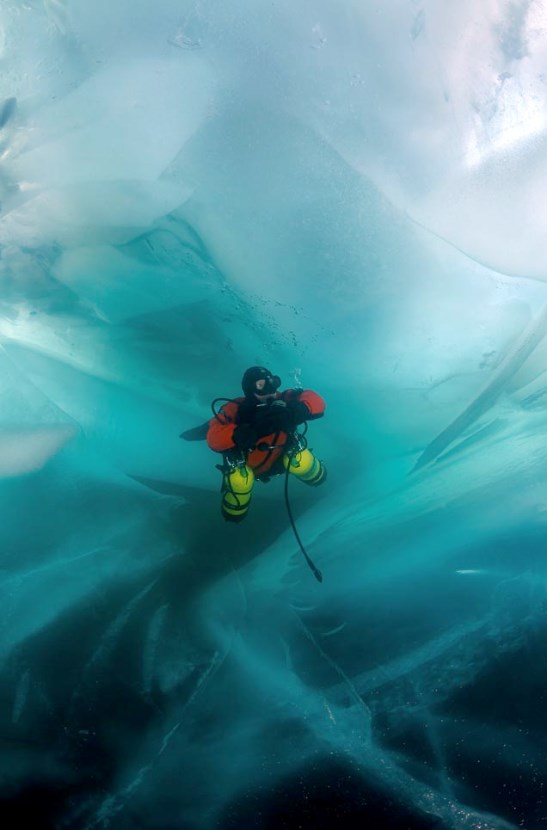
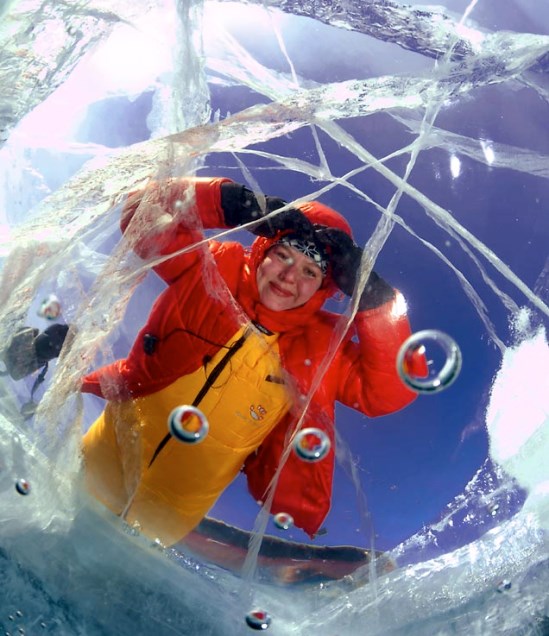 I had got to hear about Baikal much earlier than this theme was learned during a geography lesson in school. Now young people sing nothing but karaoke, but 20 years ago there was no Russian family feast without a choral singing. And when people had already drunk a lot, someone from the older generation started singing “The Glorious Sea, Sacred Baikal” or “The wild steppes of Transbaikalia”. We, the children, didn’t understand the truth behind these words, but we were impressed with heroic stories and total enthusiasm, which we felt while listening to the performers. An incredible mix of Baikal’s geographical names, local nicknames of menacing winds and confused ideas about the region’s topography wandered in the children’s minds. According to the songs endless steppes were located around a formidable sea and there were impenetrable jungles inhabited by voracious predators. Vagrants and fine young men who were the Russian prototypes for “Pathfinder” from Fenimore Cooper’s novels lived there. We can say that the ideas laid about the lake in early childhood were the most romantic. And during the school years numbers were added to the naked romanticism, which established an aura over a place of miracles created by nature. The depth is more than a mile, there is one-fifth of the world’s clean, fresh water, and we can see a considerable number of animals found only here and nowhere else. That’s probably why almost every person dreams about visiting this legendary lake at least once in a lifetime. And, of course, I was not an exception. When they asked me if I wanted to go to Lake Baikal, I said “yes!” without waiting for the end of the question.
I had got to hear about Baikal much earlier than this theme was learned during a geography lesson in school. Now young people sing nothing but karaoke, but 20 years ago there was no Russian family feast without a choral singing. And when people had already drunk a lot, someone from the older generation started singing “The Glorious Sea, Sacred Baikal” or “The wild steppes of Transbaikalia”. We, the children, didn’t understand the truth behind these words, but we were impressed with heroic stories and total enthusiasm, which we felt while listening to the performers. An incredible mix of Baikal’s geographical names, local nicknames of menacing winds and confused ideas about the region’s topography wandered in the children’s minds. According to the songs endless steppes were located around a formidable sea and there were impenetrable jungles inhabited by voracious predators. Vagrants and fine young men who were the Russian prototypes for “Pathfinder” from Fenimore Cooper’s novels lived there. We can say that the ideas laid about the lake in early childhood were the most romantic. And during the school years numbers were added to the naked romanticism, which established an aura over a place of miracles created by nature. The depth is more than a mile, there is one-fifth of the world’s clean, fresh water, and we can see a considerable number of animals found only here and nowhere else. That’s probably why almost every person dreams about visiting this legendary lake at least once in a lifetime. And, of course, I was not an exception. When they asked me if I wanted to go to Lake Baikal, I said “yes!” without waiting for the end of the question.
Almost 6,000 kilometers and four different kinds of transport were left behind. I had to change transport for three times and, finally, I got to Siberia, Lake Baikal. Gennady Misan, the director of the dive-center “BaikalTek” met our group at the Irkutsk airport, and took us to the island of Ol’hon. A wooden estate situated in Khuzhir, the main village of the island, was our place of residence for the next week. Before the trip I had thoroughly looked through the Internet pages concerning Lake Baikal and without any hints could indicate that Ol’hon Island was the largest island of the lake, located in its middle part, near its western shore. Its maximum length is 71 km, width is 12 km. The western side of the island is washed by the Small sea which is a huge shallow bay (or more precisely it is a strait). Its width is 20 km. But the bottom on the other side of the island is literally an abyss. The deepest point of Lake Baikal (1642 m) is only in 5 – 6 kilometers from the bank. But as a saying goes, seeing is believing so it’s better to go there than reread the published data a hundred times. After all, I came here with a specific purpose which is a detailed (in the literal sense of the word) exploration of ice in Baikal.
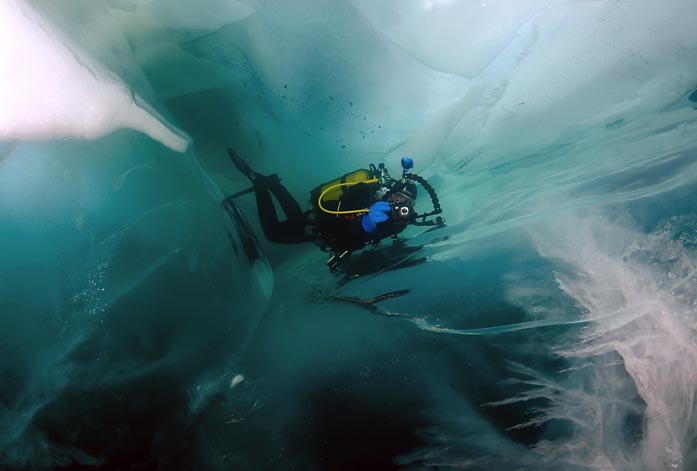
Immersions were carried out near Cape Khoboy during the first days (the northern point of Ol’hon). It is still deep winter in March on Lake Baikal. It’s 0 degrees in water and minus 20 above it and the ice separates these two layers. When I use the word ice, I mean, first of all, one of aggregate states of water. Do you remember from school physics course that it can be solid, liquid or gaseous? But I’d never seen so much of this physical state at a time: the weather was clear and the solid surface stretched for tens of kilometers, as far as one’s eye could see. Some spots were smooth, some swollen with hummocks, some were black because of depth that could be seen through the ice and some spots were milky white. Every day we had to cover 30 – 40 km to get to dive sites, and the icy horizon moved all the time ahead of us. And if we decided to travel to the north or to the south not 30 but 300 km, we always would see the same picture. Ice, ice and ice was everywhere. 30 thousand square kilometers of ice! But ice was so different in various places! It was even difficult to imagine what frost, wind, currents and the sun could have sculptured from simple H2O. Nowadays we are often delighted with ice sculptures shown during competitions often held in different countries. Masters cut statures of humans, animals, fairy-tale heroes and monuments of ice. You can’t see all this in Mother Nature’s workshops (or you can if applying fantasy). It creates mostly in the abstract style, but it’s no less talented because of this. As an example we should mention the artful design of ice stalactites formed on the bank rocks during the December storms. Icicles bend in imaginable and unimaginable forms, twist, untwist and intertwine. Their diameter is like pencil’s one but sometimes they are even thicker than a human hand. Ice that forms them may look like a glossy milk glass, crystal bars or quartz druzes. Under the icy bank caves and grottoes, ice crystals create something that is uniquely associated with the word “palaces”. And if the fairy tale Snow Queen really exists then she must live here!
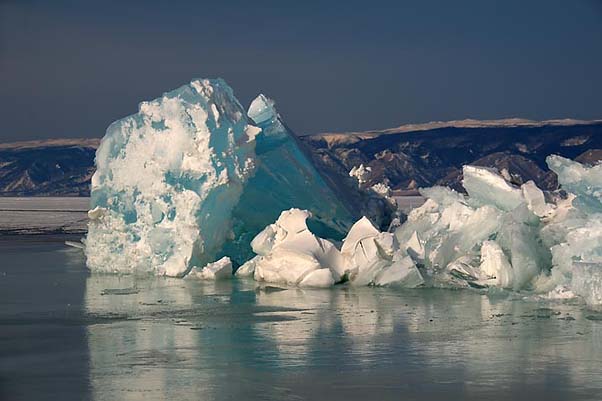
During the journey time my standard reading was printouts of V. B. Shostakovich’s “The Ice on Lake Baikal” published in 1908. I managed to draw a lot of interesting facts from the book. That was how I learned that Baikal usually began freezing with the Small Sea on December 21. Freeze-up finished on the 16th of January covering an opened part of the lake near the island of Ol’hon. “...a young, newly formed ice is very thin... it is possible for a man to stand on the ice cover with a thickness of 5 cm, and when it is 16 cm horses are allowed to move there”. Nowadays “horses are allowed to move” is not relevant any more, and people drive there, and preference is given to off-road vehicles. Taking into account that ice thickness comes to 100 – 120 cm by March (the time of my arrival) it could stand even a tank’s weight. The reverse side of the “ice road’s” strength is difficulty in cutting an ice-hole for diving. A petrol-powered saw, of course, helps out, but even this device is unable to defeat the entire thickness of the ice in a single pass. Ice “cubes” from an ice hole must be removed in layers.
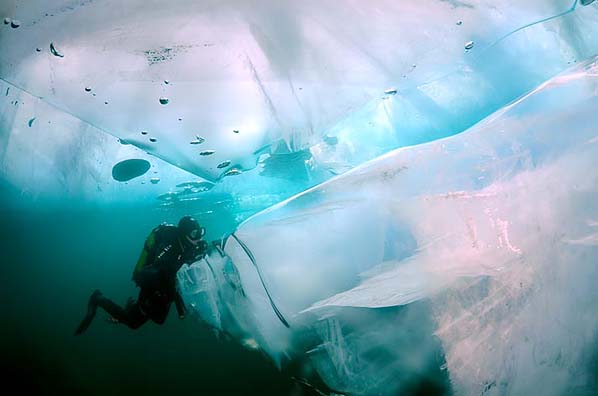
The ice-hole is cleared, the way down is free. If the purpose of diving is to admire the ice from under the water, the hole is usually made close to a “push”. Here’s how V. B. Shostakovich describes it in the article. “In their final state pushes are represented by slits, the edges of the slits are pressed against each other. A hummock, covering a slit like a dome, is formed of the gap broken edges.” The underwater view is also quite picturesque: there are disorderly piled ice floes, ice caves and grottos formed by an edge of one of the ice parts going down. Scientists explain the formation of “pushes” by thermal expansion of ice. It turns out that the night and day temperature difference at 20 degrees (and it is common for Lake Baikal) expands one kilometer of ice for nearly half a meter! And can you think about 10 or 20 km? That’s why ice is constantly in motion on Lake Baikal. When you go in the morning it’s a good riddance, and by the evening you have to lay the hook in a dozen kilometers to go round a six-foot swell formed under a fresh crack. Or you have to arm yourself with ice picks and shovels to clear a passage in it that a car could overcome there. Push formation is accompanied by a bang and crash comparable to the noise of a cannonade. And if it may cause some inconveniences on the surface, then it is much more unpleasant under the water. Our group once almost caught hell because of this natural phenomenon. We dived with a French group of divers to see a crack somewhere in the middle of the Small sea. The purpose of the immersion was to take photos and shoot interesting relief details of the lower part of the ice-surface. Operators and their models looked for picturesque cliffs and ice caves. There were no signs of surprises. Suddenly... Hardly the last swimmer had left one of the underwater ice caves as there was a heartbreaking crash and the ice that formed walls of the cave, piled up like a house of cards!
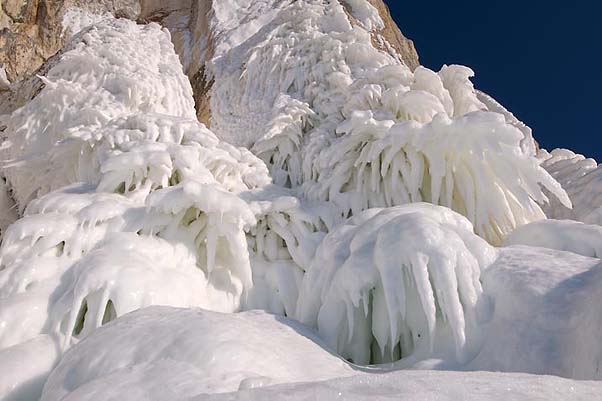
There are many terms that are used to describe ice on Lake Baikal. Several basic types of ice are mentioned in the Shostakovich’s work. They are “sokuy”, “osenets” and “kolobovnik”. Sokuy appears in late autumn at the lake shallows. Water freezes at the bank and waves, rolling on the edge, are touched by frost at night and that’s why the amount of ice gradually increases and moves towards the lake. Ice is white, opaque and porous with corrugated surface and can form swells which “sometimes reach the height of two yards.” Osenets appears when broken floating ice freezes. It’s also rough and opaque, one can noticed some fragments of damaged ice there. The next type of ice looks very picturesque, this is kolobovnik. It is formed by “balls” frozen in clear ice. The balls are chunks of floating ice which got spherical shapes. If the pieces are large enough they remind white plates laid out on the dark ice surface. In this case, the ice is called “tchashechniy” (“tchashka is Russian for a “cup”) or “tarelochniy” (“tarelka” is Russian for a “plate”). Clear smooth ice which has all these frozen installations inside doesn’t have its own local name, but from my point of view, it is the most interesting object for photo and video shooting. Water in the lake reminds distilled according to its chemical composition (or it’s better to say according to its lack). “Glass” of extraordinary optical purity appears when frost binds its smooth surface. If you look at people moving on the ice surface from under it, it is hard to believe that the thickness of the ice “window” is 80 – 100 cm. There is an impression that you can reach out your hand and touch them. Only bubbles of your regulator, hitting the bottom of the ice surface, give an idea about the true state of things in some degree. When you watch a diver through the surface between your shoes (he is floating in the depth of 10 meters), you feel a treacherous chill on your back from time to time, and you are afraid that suddenly the magic spell will be dispelled, and you’ll collapse getting into a deep abyss under your feet.
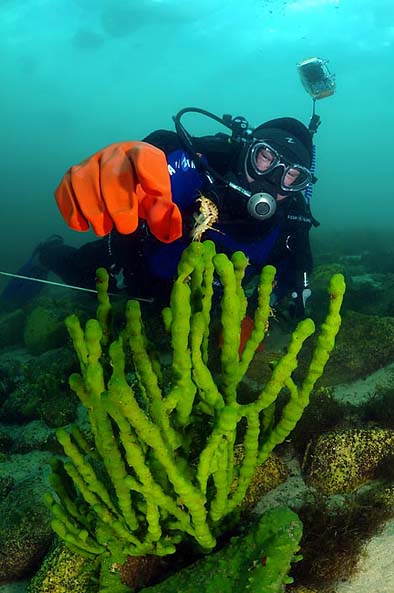 During the under-ice diving we were able to add information on V. B. Shostakovich’s types of Baikal ice. In principle, it is not surprising since the hydrologist wrote his work in 1908 when the lower surface of the ice was simply not available. And it was under the surface where we saw such a thing as underwater snow. Yes, yes it was snow (or something that looked like snow)! It is difficult to speak about its origin (wind could upset an ice floe with a snowdrift or maybe this was one of the stages of ice crystallization), but we could scoop this white substance and do real snowballs. And if talking about an aesthetic side of the question we all could write a separate treatise about it. Every dive brought new shots of unusual ice formations. Ice caves, grottos and tunnels formed by a push. Thin broken and frozen ice looked like tiles and resembled a fairy-tale dragon's teeth. With their heads down ice floes resembled sometimes the well-known mountain peaks (e.g. two-headed snowy lump definitely looked like Mount Elbrus). It is difficult to describe the full range of icy miracles that we had a chance to peep contemplating “mother nature’s” freaks.
During the under-ice diving we were able to add information on V. B. Shostakovich’s types of Baikal ice. In principle, it is not surprising since the hydrologist wrote his work in 1908 when the lower surface of the ice was simply not available. And it was under the surface where we saw such a thing as underwater snow. Yes, yes it was snow (or something that looked like snow)! It is difficult to speak about its origin (wind could upset an ice floe with a snowdrift or maybe this was one of the stages of ice crystallization), but we could scoop this white substance and do real snowballs. And if talking about an aesthetic side of the question we all could write a separate treatise about it. Every dive brought new shots of unusual ice formations. Ice caves, grottos and tunnels formed by a push. Thin broken and frozen ice looked like tiles and resembled a fairy-tale dragon's teeth. With their heads down ice floes resembled sometimes the well-known mountain peaks (e.g. two-headed snowy lump definitely looked like Mount Elbrus). It is difficult to describe the full range of icy miracles that we had a chance to peep contemplating “mother nature’s” freaks.
Starting from April, the ice shell of the lake gradually gets thinner (1 cm in three days) and Baikal starts to lose its ice in May (in the northern part the break-up begins in the last decade of May). But winter is losing its power with great reluctance, and floating ice can be often found even in late June. Then follows a transient Baikal summer, when water temperature on the surface rises to 11 degrees (in shallow bays to 22 – 23). Then once again, nature starts its winter preparations. Presaging the ice kingdom to return, young shore ice appears in bays in mid-November.
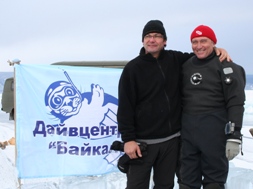 Six days of diving flashed like an instant. Many of Lake Baikal wonders stayed behind the scenes, for example, the unique flora and fauna of the lake. It is asleep in winter. Only two dives gave us a possibility to see similar to corals Baikal sponges and an endemic of the lake gammarus which is a large amphipod crustacean. But there are more: the famous nerpa (Baikal seal), the unique live-bearing fish golomyanka and the Baikal sturgeon (Acipenser baerii). And it would be nice to meet omul of Baikal which is well known occupant of mysterious barrels from a Russian legend. Well, that will be the reason to come to Lake Baikal once again. Probably, this severe but generous place is like some kind of unknown virus that makes a person, who has visited the lake, come back here again and again. A famous French underwater cameraman Didier Noirot accepts this idea. I was fortunate to meet him during my stay with BaikalTek. He admits that there are only three places in the world where he is ready to come again and again. And one of them is Lake Baikal. Glorious and sacred Russian sea.
Six days of diving flashed like an instant. Many of Lake Baikal wonders stayed behind the scenes, for example, the unique flora and fauna of the lake. It is asleep in winter. Only two dives gave us a possibility to see similar to corals Baikal sponges and an endemic of the lake gammarus which is a large amphipod crustacean. But there are more: the famous nerpa (Baikal seal), the unique live-bearing fish golomyanka and the Baikal sturgeon (Acipenser baerii). And it would be nice to meet omul of Baikal which is well known occupant of mysterious barrels from a Russian legend. Well, that will be the reason to come to Lake Baikal once again. Probably, this severe but generous place is like some kind of unknown virus that makes a person, who has visited the lake, come back here again and again. A famous French underwater cameraman Didier Noirot accepts this idea. I was fortunate to meet him during my stay with BaikalTek. He admits that there are only three places in the world where he is ready to come again and again. And one of them is Lake Baikal. Glorious and sacred Russian sea.
 Some tips for divers. In January Baikal freezes. It often happens in the second half of January (very rarely, but sometimes this can be seen in late December). The ice thickness at this time is 10 – 20 cm. Ice is thick and clear but it is forbidden to go there by car. In February the ice thickness reaches 50 – 100 cm. Ice is thick and very firm. Cracks appear in early February as a result of temperature differences, you can travel on ice in a jeep. The best time is the end of February, early March. The thickness of ice is 80 – 120 cm. Ice is thick and very firm. This is the time when you can observe the formation of hummocks and of other different ice frills as underwater caves and tunnels. The water temperature during this time is 0 and the air temperature is –10, –25 C.
Some tips for divers. In January Baikal freezes. It often happens in the second half of January (very rarely, but sometimes this can be seen in late December). The ice thickness at this time is 10 – 20 cm. Ice is thick and clear but it is forbidden to go there by car. In February the ice thickness reaches 50 – 100 cm. Ice is thick and very firm. Cracks appear in early February as a result of temperature differences, you can travel on ice in a jeep. The best time is the end of February, early March. The thickness of ice is 80 – 120 cm. Ice is thick and very firm. This is the time when you can observe the formation of hummocks and of other different ice frills as underwater caves and tunnels. The water temperature during this time is 0 and the air temperature is –10, –25 C.
When you are there you should have 2 regulators for winter, a dry suit and the ICE DIVING certificate. But the most important thing is your desire, because you can get the equipment and ice diving training there, on the lake.
More information about diving at Lake Baikal you can find on the dive-center BaikalTek’s website: http://www.baikaldiving.ru/en/ , or ask your questions via email: info@baikaldiving.ru .
Text by Alexander Kurakin and Andrey Nekrasov
Photos by Andrey Nekrasov